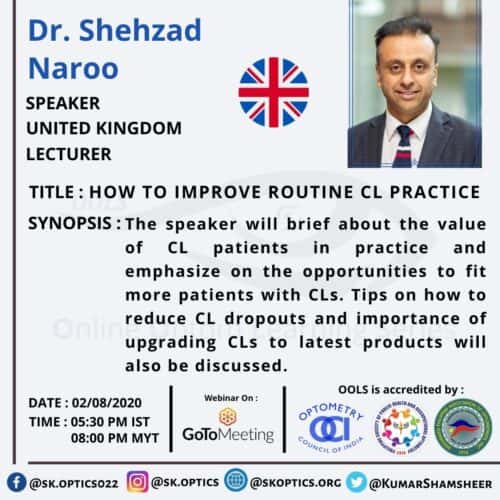
Dr. Shezad Naroo begins by telling us about the low rates of contact lens (CL) wear across the world, which is only about 3.3% of the population. He points out that in the United Kingdom, in general patients appreciate good eye care and less than a third had financial concerns with eye care in 2005.
However, a staggering 20% of the population were CL dropouts in the first few months. He makes a strong case about why CL prescribing is more profitable to practice as compared to prescribing only spectacles. He then walks us through multiple ways where practitioners can introduce the idea of CLs to their patients. He also talks about how to make the patient most comfortable and even convert dropouts into successful CL wearers.
Dr. Naroo explains how practitioners can troubleshoot effectively by addressing common patient problems. He talks about the common issues that patients face when wearing CL for the first time. These include patients with presbyopia and patients with astigmatism. He briefly explains how to upgrade existing CL wearers to better products.
He describes how to tackle non-compliance among patients to reduce dropouts by providing pamphlets, using appropriate patient language, and connecting with the patients more often, and reinforcing the right CL care practices. He also speaks about how some of the most profitable eye care practices have more CL wearers as patients. Lastly, he ends his talk with some clinically essential tips for the practitioners fitting CL. A question-answer session follows this with some questions relating to real-life experiences and some very great insights.
References
Editorials
Akerman D. Our greatest opportunity. Cont Lens Anterior Eye. 2018
https://pubmed.ncbi.nlm.nih.gov/29884591/
Naroo SA. Contact lens dropouts–‘must try harder’. Cont Lens Anterior Eye. 2012
https://pubmed.ncbi.nlm.nih.gov/22986009/
Euromcontact survey annual statistics reports
https://euromcontact.org/publications/annual-statistics-reports/
Expanding your contact lens practice
Jones L, Jones D, Langley C, Houlford M. Reactive or proactive contact lens fitting — does it make a difference? Journal of The British Contact Lens Association 1996
https://www.sciencedirect.com/science/article/abs/pii/S0141703796800310
Atkins NP, Morgan SL, Morgan PB. Enhancing the approach to selecting eyewear (EASE): a multi-centre, practice-based study into the effect of applying contact lenses prior to spectacle dispensing. Cont Lens Anterior Eye. 2009;32(3):103-107.
https://pubmed.ncbi.nlm.nih.gov/19297236/
Nichols KK, Redfern RL, Jacob JT, et al. The TFOS International Workshop on Contact Lens Discomfort: report of the definition and classification subcommittee. Invest Ophthalmol Vis Sci. 2013;54(11):TFOS14-TFOS19.
https://pubmed.ncbi.nlm.nih.gov/24058134/
Contact lens wear discontinuation
Pritchard N, Fonn D, Brazeau D. Discontinuation of contact lens wear: a survey. Int Contact Lens Clin. 1999;26(6):157-162.
https://pubmed.ncbi.nlm.nih.gov/11384832/
Dumbleton K, Woods CA, Jones LW, Fonn D. The impact of contemporary contact lenses on contact lens discontinuation. Eye Contact Lens. 2013;39(1):93-99.
https://pubmed.ncbi.nlm.nih.gov/23266586/
Stahl U, Keir NJ, Landers A, Jones LW. Effect of Short Recovery Periods on Ocular Comfort During Daily Lens Wear. Optom Vis Sci. 2016;93(8):861-871.
